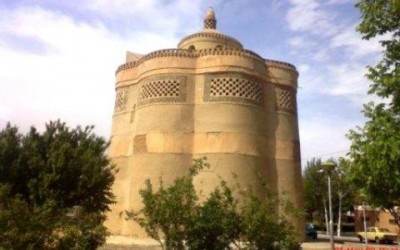Kabutarkhana (the nest of pigeons) is one of the most prominent Iranian medieval towers dating back to pre-Islamic times (Mirzaie, 2003, p. 132). Kabutarkhana was mainly located in plains with mild temperatures beside rivers, canals, and aqueducts. The farther we got from the plains, the fewer the Kaburakhanas were (Muhammadinejad, 2011, pp. 13-14). Kabutarkhanas were also constructed in Yazd and Azarbayejan (ibid, p. 115). In ancient times, breeding pigeons was common in Isfahan and there were special markets to sell different birds like pigeons (Azari Damirchi, 1972, p. 34).
Regarding its economic function, pigeon droppings were used for agricultural purposes to grow summer crops and vineyards. Farmers constructed Kabutakhana to settle pigeons and use their droppings to fertilize their lands and grow summer crops like melon and watermelon (Chardin, 1927, V. 4, pp. 122-124; Dieulafoy, 1989, pp. 283-284; Kaempfer, 1968, p. 217; Muhammadinejad, 2011, p. 12; Mirzaie, 2007, p. 112). The droppings of towers were gathered once a year, and then they were dried in the sunlight (Mahmudian, 2000, p. 60). Moreover, farmers sold these droppings to others not having Kabutarkhana to produce fertilizers (Muhammadinejad, 2011, p. 13).
Architecturally, the structure of Kabutarkhana was so beautiful and coordinated with its function. The towers were mostly constructed as a single cylinder or a combination of several cylinders. There were also some kabutakhana constructed according to the rectangular plan (Mohammadinejad, 2011, p. 13). All interior walls were constructed to settle pairs of pigeons without wasting a single piece of the wall (Muhammadinejad, 2011, p. 13).
Borjak (the small towers) placed at the top of the towers were the ways through which pigeons enter or exit (ibid., p. 17; Mirzaie, 2007, p. 126; Mirfattah, 1978, p. 38). Occasionally, Kabutarkhana had one or two small doors for just one person to go in and gather the droppings. These small doors were sealed so that no other animals, such as snakes, could enter the towers (Mirzaie, 2007, p. 127).
These striking towers were constructed by anonymous architects living among ordinary people. They were decorated with calligraphy, geometric patterns, arabesques and plant patterns on bricks and plasters (Muhammadinejad, 2011, p. 17).
As an example of Iranian medieval history, Kabutarkhana examplifies both its delicate structure and economic function. Indicating the close relationship between human beings and nature, Kabutarkhana shows how the medieval ordinary applied architecture to manipulate nature.
Maryam Kamali
Chardin, Sir John (1927). Sir John Chardin’s Travels in Persia, with an introduction by Sir Percy Skyes, tr. by E. Loyd. London: The Argonaut Press.
Dieulafoy, Jane (1989). La Perse, la Chaldee et la Susiane: relation de voyage, per Jane Dieulafoy, Sahab Geographic.
Jackson, Abraham Valentine Williams (1975). Persia Past and Present: a book of travel and research, New York: AMS Press Inc.
Kaempfer, Engelbert (1968). Die Reisetagebucher Engelbert Kaempfer, Bearbeitet von Karl Meier, Lemgo, mit 3 Karten und 12 Taflen, Wiesbaden: Franz Steiner.
Azari Damirchi, Ala’al-Din, “Kabutar wa Kabutarkhanaha-ye Esfahan”, Honar wa Mardom, 1972, n. 115, pp. 34-37.
Mirfattah, Aliasqar, “Borjha-ye Kabutar”, Kava, 1972, n. 67, pp. 32-38.
Mirzaie, Seyed Ayatollah, “Kawoshi darbare-ye wijegiha-ye Farhangi wa Eqtesadi Kabutarkhanehaya Ostovanaie shekl”, Namaya Insanshenasi, 2003, n. 4, pp. 115-139.
Mirzaie, Seyed Ayatollah, “Moqayese-ye Barkhi Wijegiha wa Karkerdhaya Kabutarkhana-haya Iran and England”, Olum-e Ejtema’i-ye Allama, 2007, n. 37, pp. 109-144.
Muhammadinejad Marjan, “Borj-e Kabutarkhana”, Roshd-e Amuzesh-e Honar, 2011, n. 28, pp. 12-17.




